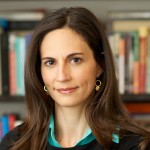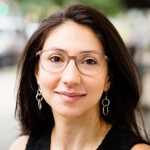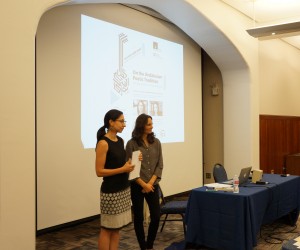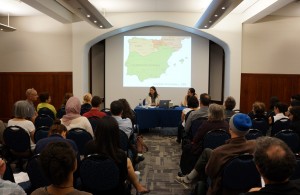- Date: September 29, 2015
- Location: University of Pennsylvania - Houston Hall, Benjamin Franklin Room
A Talk by Dr. Huda Fakhredine and Dr. Lital Levy


An introduction to the celebrated legacy of Al-Andalus (Islamic Spain) through the lens of the muwashshah. A unique poetic form, the muwashshah embodied the spirit of convivencia by incorporating elements from Romance, Arab, and Hebrew cultures. The talk covered the historical backdrop of Al-Andalus, the development of the muwashshah form in Arabic poetry, its adoption by Andalusian Hebrew poets, and its legacy in both Arabic and Hebrew after the expulsion from Spain.

Al-Bustan is pleased to have presented the first event of Words Adorned with University of Pennsylvania’s Department of Near Eastern Languages and Civilizations (NELC). Dr. Huda Fakhreddine and Dr. Lital Levy spoke about muwashshahat, a form of Arabic poetry popularized in Al-Andalus, Islamic Spain. The attendees, comprised of over 50 people, were introduced to the history and culture of Al-Andalus, with an overview of Arab poetry and the significance of muwashshahat as a poetic form and its impact on both Arab and Jewish culture.
Dr. Fakhreddine spoke primarily on the literary qualities of muwashshahat and how it compares to the Arabic qasida (the classic Arabic poetic form). As she stated:
The term muwashshah means that which is adorned and of course the project is called Words Adorned and the first thing that comes to mind is embellishment or adornment in clothing or in the form of jewelry. That is exactly what the word poetically means. Poetically it refers to poetry composed in an extended ‘urud, meaning an extended metrical form a variation and adaptation in the opening of the classical system of metrics.
By examining concepts such as theme and meter within muwashshahat, Arabic qasida, and modern Arabic poetry, Dr. Fakhreddine was able to discern stages in the evolution of Arabic poetry. She emphasized that:
The most important dominant feature, the characterizing feature of the muwashshah is rhyming, where as your pre-Islamic poet had one rhyme marking the end of his verse. The washshah, the author of the muwashshah, now created more ends for his line allowing himself to create more rhymes. And the rhymes are the embellishments they are the jewels at the end of every line.

She ended her presentation with an excerpt from the poem “Eleven Stars Over Andalusia” by Mahmoud Darwish that alludes to the prominence of Al-Andalus in Arab culture.
Dr. Levy’s presentation provided a window into the way that muwashshahat influenced Jewish culture in Al-Andalus, and its legacy in contemporary Jewish culture. As she noted:
…Previously in Babylon, Jews had used Aramaic over the course of the couple generations, and then replaced it with Arabic. Jews come to use Arabic both for their scholarly productions and for everyday communication. In fact the penetration of Arabic in Islamic culture was so thorough that Arabic words entered Jewish culture even in the contexts of religion. For instance, Allah for God, Quran for Torah and so forth.
An expert on the interplay between Arabic and Hebrew in contemporary Palestine and Israel, Dr. Levy spoke about the prominence of Arabic in all aspects of Jewish life in Al-Andalus—not only was Arabic the lingua franca in Al-Andalus, it actually influenced the Hebrew poetic forms of that era. She explained:
Arabic speaking Jews had both Arabic and Hebrew names. . . Essentially Hebrew takes the status of the ceremonial language and Arabic is the language of communication. We can also see the influence of Islam on Jewish prayer customs in Islamic lands, like washing feet, and not only hands, before prayer — that’s something that is adopted from Islamic practice.


